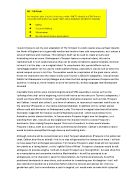During this aside, Caliban is presented as malevolent by the malicious tone he adopts when conflicting against Prospero. The hatred was provided by Shakespeare originally through a patronizing and despondent diction applied by Caliban “The Red plague rid you for learning me your language” (Page: 47-8, Lines: 64-5). Djimou Hounson accurately adapts Caliban’s agitation illustrated in the script by altering his character’s body language to expressively reciprocate the ferocity of Caliban which Shakespeare aimed to present to the audience (He is seen making strange hand gestures whilst stressing an emphasis on specific words) (Page: 47-8, Lines: 64-5).
In contrast to how Julie Taymor kept up multiple aspects of Shakespeare’s original The ‘Tempest’, she also introduced an intelligent alteration to the main protagonist’s gender. The use of Hellen Mirren as Prospera as compared to the original Prospero, frequently lends itself to aid the character’s affection and passion expressed by Prospera. As a female, her ability to convey sentiment aided the dramatic elation beyond the capability of such expression from that of a male advocate. This is evidential in the dialogue in Act: 5, Scene: 1, Pages: 173-177, Lines: 32-100. Hellen Mirren displays attachment to the magical spirit of Ariel. In addition Julie Taymor applies close juxtapositions between Ariel and Prospera to powerfully expose the aptitude of their companionship.
On the other hand, Shakespeare hardly shows any strength in the attachment between them. So in the case of dramatic strategies, I believe that the adaptation proved give more importance to the credibility of the bond between Prospero and Ariel as compared to the original. However, the concentration on the dramatic effects crucially disrupted the importance of the speech which allowed the audience to miss the imagery that Shakespeare tries to grow in the audiences mind “A solemn air, and the best comforter to an unsettled fancy, cure thy brains. Now useless, boiled within thy skull.” (Act: 5, Scene: 1, Page: 175 Lines: 57-60). Though the imagery doesn’t affect the adaptation as it is a movie and leaves very little to the imagination of the audience, and therefore making the use of imagery redundant.
Shakespeare adds a powerful epilogue by the central character that brings the play to a melodious end. He makes use of flowing structures such as rhyme to give the poetic speech a rhythm “Now my charms are o’erthrown and what strength I have’s mine own…” (Act: 5, Scene: 1, Lines: 1, 2). He uses an iambic pentameter to stress prominence on key words that he intended would be heeded by the spectators “As you from crimes would pardoned be, let your indulgence set me free.” (Act: 5, Scene: 1, Lines: 19, 20).
To end the original play, Prospero returns to deliver an epilogue to the audience, when everyone else has left the stage. He asks them to release him from the island. His magic is at an end and he will have to remain on the island unless they free him through the power of their applause “But release me from my bands with the help of your good hands.”(Act: 5, Scene: 1, Lines: 9, 10). This epilogue by Prospero has often been linked to Shakespeare’s farewell to writing. In this address to the audience, Prospero is constantly asking for redemption and freedom. This can be cross related to Shakespeare asking for a final applaud and liberty from script work and retire to his family life.
In comparison to the original, the adaptation does not string along with the illusion Shakespeare talking to the audience through his protagonist. As Prospera does not show a link to Shakespeare as she is a male and therefore Taymor is not aiming to highlight the possibility of Prospero being Shakespeare in disguise.
Instead, Julie Taymor sheds light on the plea from Prospera in anticipation for proclamation by the viewers. As it was reproduced as a movie rather than a play, the cinematography allows for more attention to be given to Prospera’s facial expressions, her juxtapositions and her choreographed gestures. Even though Shakespeare could not write for that, the epilogue gives space for there to be justified assumption of emotions to be made, giving Helen Mirren’s performance sentimental value.
In conclusion to my comparisons, I believe that both the original and the adaptation have different purposes. The original is a final abode from Shakespeare to the world of literature, which exposes his true ambitions of retiring as well as highlighting the illusion of power. In contrast to that, the adaptation focuses on divulging each character’s motifs and feelings, merging that with the gripping graphics and convincingly prominent sets to create an artistically dramatic representation of the original composition.







